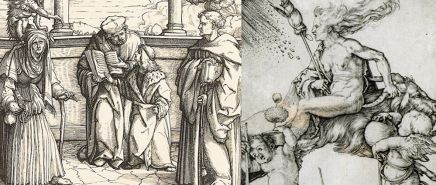MNK The Sukiennice
Rynek Główny 3 Michałowski Room, The Gallery of the 19th century Polish Art in Sukiennice- mon: closed
- Tuesday - Sunday: 10.00 - 18.00
Information and reservations on weekdays 9 a.m.- 4 p.m.
The Director of the National Museum in Krakow
Deputy Director for Programme Activity
Deputy Director for Strategy and Communications
Deputy director for the Management
Chief Accountant
Chief Cataloguer of the National Museum in Krakow
Chief Conservator

Human knowledge and human power meet in one; for where the cause is not known the effect cannot be produced – these are the words by Francis Bacon (1561-1626) were announced at the dawn of era, called by the future historians the scientific revolution of the 17th century. According to the author of the New Organon, nature should be studied within the realm of physics and metaphysics, both of which require certain practical skills id est: mechanics and magic (in a purer sense of the word).
The pure magic, in its baconian meaning, was quite distant from the eclectic ceremonies held with use of spells and artifacts. It should have become a method that served the philosophers of nature in gathering the facts on phenomena that surpass sensual perception. Mechanistic vision of the universe created by scientists like Descartes (1596 - 1650) and Newton (1642-1726) did not exclude this kind of magic. Epistemological value of sorcery, as well as the moral consequence of its practices, seems to have been constantly discussed in these days.
Masters of the Renaissance art have assigned the magic, or rather certain types of therein, to the figure of a woman, thereby creating one of the most powerful icons of our culture. Even though the newest historiography verifies opinion on the exclusively feminine genre of the professions connected with witchcraft, we are still attached to the image of the witch created under the strong influence of Holbein (1497 - 1543), Dürer (1471 - 1528), Grien (1484 - 1545) or even Bruegel (c.1526 - 1569).
Looking at the growing popularity of witchcraft representation, in 17th century prints, we may ask what these images could possibly tell us about the skills of the sorceress depicted in the age of Galileo Galilei and Newton.
In the era of the scientific revolution the laboratory, herbal garden as well as the astronomical observatory became the new spaces of science. In the same time the images of witches were often enriched with variety of the details - depictions of tools, that used to furnish a pharmacy or a alchemist workshop. The world represented by that means, even though often shown in a curved mirror, does not necessarily fit to the image of the witch neither as a simple folk woman nor the Michelet’s feminine rebel.
The exhibited prints have been chosen from the collection of the Print Room in the Scientific Library of the Polish Academy of Arts and Sciences and the Polish Academy of Sciences in Krakow, as well as from The Jagiellonian Library and the National Museum in Krakow.
Prints by Albrecht Dürer, Marcantonio Raimondi, Agostino dei Musi after Rafael Santi, as well as Theodor de Bry after Peter Bruegel the Elder are going to be presented along some works by Jan van der Velde and Francisco Goya.
The exhibition curator, script & commentaries by: Anna Olszewska
Sukiennice, Cloth Hall, exhibition, National Museum Krakow, power